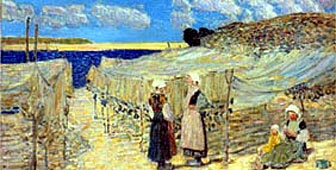American Impressionism makes rare appearance

Lausanne's Hermitage museum is shedding light on an art movement which remains largely unknown in Europe - American Impressionism.
Although numerous exhibitions in Europe have focused on the birth and growth of Impressionism in France, relatively few museums include works by American Impressionists in their permanent collections.
Yet while Impressionism marked a fundamental watershed in the history of modern art, the United States was one of only a few countries to give it such a warm welcome.
Thanks to the efforts of a number of Parisian art dealers such as Paul Durand-Ruel, the American public was to discover the artists of the new French school through exhibitions during the 1880s. Fascinated by the Impressionists’ work, several American painters visited France, and in particular they went to Giverny where Monet lived.
The influence of Impressionism on the American artists was to combine with the heritage of the great American landscape painters and produce a truly original style of its own.
Representing nature
“In America,” says William Hauptman, curator of the Hermitage exhibition, “there was already a strong tradition of the representation of nature by the Hudson River school. “One critic of the time put it well when he said that the subject of American art should be the landscape.
“So at the end of the 1860s, after the civil war, many American painters opened their horizons and went to France. It was very liberating for them.”
Just how liberating is made clear by the works exhibited in Lausanne. Most are on loan from US museums and private collections, and many are making their first appearance in Europe.
Describing them with such phrases as “a symphony of colour”, Hauptman told swissinfo that the American artists who went to France returned home to develop an American Impressionist school as opposed to the French one.
Not just imitation
“This is why it’s not completely imitative – because there was a conscious effort on their part to infuse into America a certain modernity which previously had been very subdued.
“Monet and Rodin had a great deal of respect for the American Impressionists, and not just because the United States was an important market. Sometimes they received more respect for their own works than from their fellow countrymen.”
By the 1880s, American collectors were buying French paintings at a prodigious rate, one US agent spending some $3 million on them in 1883. Another factor which influenced the American painters – and led to their voyages to France – was the staging in 1886 of major exhibitions of French Impressionism in Boston and New York, both of which, says Hauptman, opened the eyes of the American public.
The exhibition includes a representative selection of works by the most important American artists of the movement, including John Leslie Breck, Dennis Miller Bunker, Mary Cassatt, William Merritt Chase, Childe Hassam, Theodore Robinson, John Singer Sargent, John Henry Twachtman, Robert Vonnoh and Julian Alden Weir.
No easy task
Getting their oil paintings to Europe was no easy task for curator Hauptman, whose previous major exhibition at the Hermitage was “The Golden Age of English Watercolours” in 1999.
“It was complicated,” he said, “and in some cases the negotiations were awesomely difficult. The events of September 11 made some museums think again before letting their pictures go to Europe by air. Added to this is the fact that Impressionist paintings tend to be fragile because of the slapdash techniques which are often involved.”
But as this rare European opportunity to see such outstanding examples of American Impressionism is sure to prove – before the exhibition ends on October 20 – it was well worth the transatlantic trip back to the continent which inspired them.
by Richard Dawson

In compliance with the JTI standards
More: SWI swissinfo.ch certified by the Journalism Trust Initiative
You can find an overview of ongoing debates with our journalists here . Please join us!
If you want to start a conversation about a topic raised in this article or want to report factual errors, email us at english@swissinfo.ch.